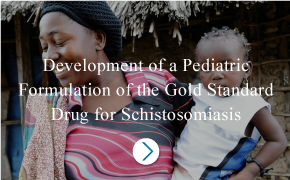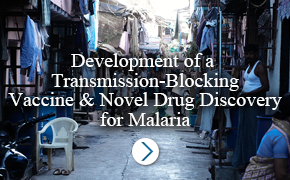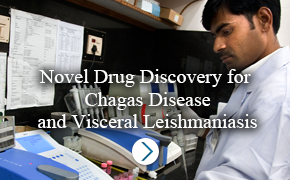Investment
Case Studies
Novel Drug Discovery for Chagas Disease
and Visceral Leishmaniasis
In order to bring the impact of the GHIT Fund’s work to life, we have
initiated the creation of case studies that convey the potential impact of our invested
innovation on economies and societies in endemic countries.
These case studies serve as a bridge between our mission, vision, and product development process by bringing into focus the ultimate goals of the GHIT Fund and all its partners: enabling those in the developing world to break free from the shackles of disease and poverty and pursue the level of prosperity and longevity now common in the industrialized world.
These case studies serve as a bridge between our mission, vision, and product development process by bringing into focus the ultimate goals of the GHIT Fund and all its partners: enabling those in the developing world to break free from the shackles of disease and poverty and pursue the level of prosperity and longevity now common in the industrialized world.
Disease Impact Overview
On the face of it, Marcella and Beatriz have little in common. Born into a family with means, and educated at some of the best schools in Europe, Marcella is now a corporate executive living in Barcelona, Spain. An ocean away, Beatriz’s family belongs to the Guarani ethnic group in rural Bolivia. Just a teenager when trafficked from her rural home and forced to become a domestic worker, Beatriz lives in slums on the outskirts of Cochabamba – an area with few signs of economic progress: water is still collected and carried by hand, there is no electricity, and the homes are simple mud hut structures.
Unknown to Marcella and Beatriz, who are each anticipating the birth of their first child, both carry the T.cruzi parasite responsible for Chagas disease, which puts the health of their unborn children at risk. Named after Brazilian physician Carlos Chagas who first described the disease, it is spread by the bite of insects known as triatominae, or “kissing bugs,” that are endemic to Latin American countries. In a historical study of 66 infants where the parasite was passed from the mother, less than half of the infants lived beyond 2 years of age1.
MaBeatriz was infected when a kissing bug carrying the parasite bit her lip. Like the majority of those infected, Beatriz did not show any immediate symptoms of the disease; she may eventually develop cardiac disorders, enlargement of the esophagus or colon, or neurological disorders 10 to 20 years after the initial infection2. Since the disease will likely go undiagnosed, it is likely that she will pass it to her unborn child and possibly to others through blood donations.
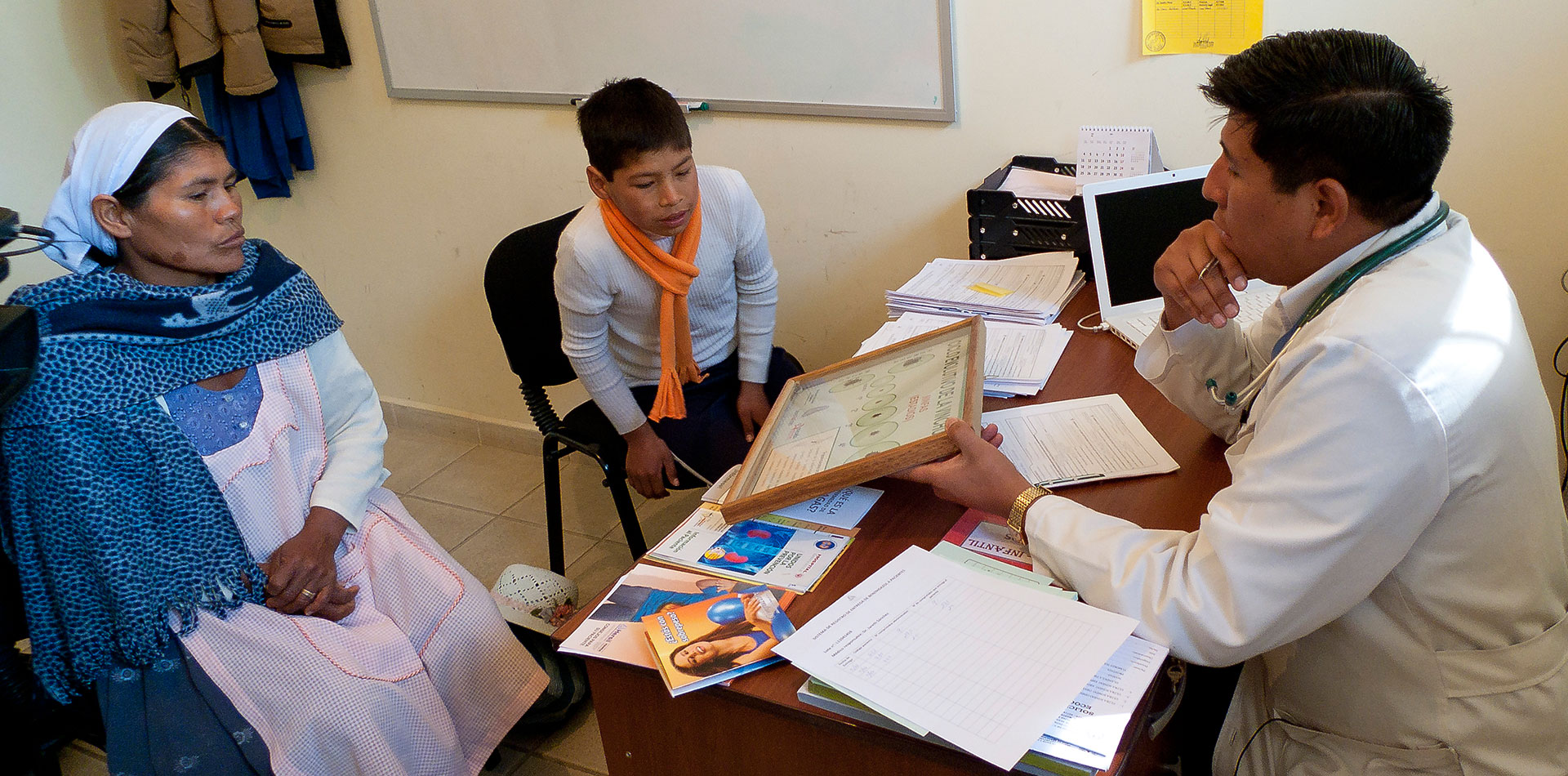 Photo Credit: DNDi
Photo Credit: DNDi
-
Kissing bugs live in the cracks of the mud walls of poor-quality housing and on the fur of
livestock. In the impoverished areas of Bolivia, estimates indicate that nearly 50% of
residences have triatomine infestation, with over 30% of those bugs carrying the T. cruzi
parasite3. Chagas disease affects an estimated 1.8 million people in Bolivia (roughly
15% of the population)4 and between 6 to 7 million people worldwide5 –
with 50,000 new cases occurring per year.6 Approximately 12,000 people die from
Chagas disease each year and 65 million people in the Americas alone are at risk for contracting
the disease.7
Marcella, living thousands of miles from the endemic regions where kissing bugs are present, was infected with Chagas disease when she received a blood transfusion containing the parasites. She too risks passing the disease to her child and spreading the disease further.
-
“MEASURES TO LIMIT CHAGAS SPREAD BY BLOOD TRANSFUSION”
An increase in blood donor screening in endemic countries has helped limit risk of Chagas disease transmission by blood transfusion. Similar screening is being instituted in non-endemic countries such as the US, France, and Spain, which receive large numbers of immigrants from high-risk areas of Latin America. The risk of transmission in non-endemic countries is very real. A recent report found that more than 15% of Bolivian patients receiving treatment at a primary care center in Barcelona, Spain tested positive for the Chagas parasite.
(Roca, C et al. PLoS neglected tropical diseases 5.4 (2011): e1135
VL is especially prevalent in impoverished areas with high population density; inadequate sanitation creates more sandfly breeding sites and poor construction allows them to easily enter homes. There are an estimated 300,000 new VL cases every year, with the majority occurring in six countries: Bangladesh, Brazil, Ethiopia, India, South Sudan and Sudan. Each year, 20,000 people die from VL and an estimated 310 million people are at risk for contracting the disease9.
Both diseases inflict devastating tolls on the economies of regions they affect. The global cost of Chagas disease, for example is estimated at $7 billion annually10. The majority of this cost burden stems from losses in workforce productivity. Globalization and immigration patterns between Latin America and the rest of the world are also compounding the spread and economic impacts of the disease. In the case of VL, a recent analysis for one of the worst affected regions in India showed that 7 months of an individual’s income was spent on treatments for the disease. In this community, 87% of households were forced to take out loans to cope with the disease burden, further illustrating how this disease contributes to increasing poverty and social decline11.
Current Treatment Options
The similarities between Chagas disease and VL do not end with their mode of transmission; both diseases are challenging to treat since the few options that exist are expensive, inefficient, and cause serious side effects. Existing VL therapies often have toxic side effects and limited benefits.
Amphotericin B liposome, considered the best existing therapy, is effective but extremely expensive ($126 to $252 for each treatment). Additionally, the product is not stable at the high temperatures in regions affected by the disease, and is given by painful injection ⎯ both of which limit patient access to and adherence with therapy.
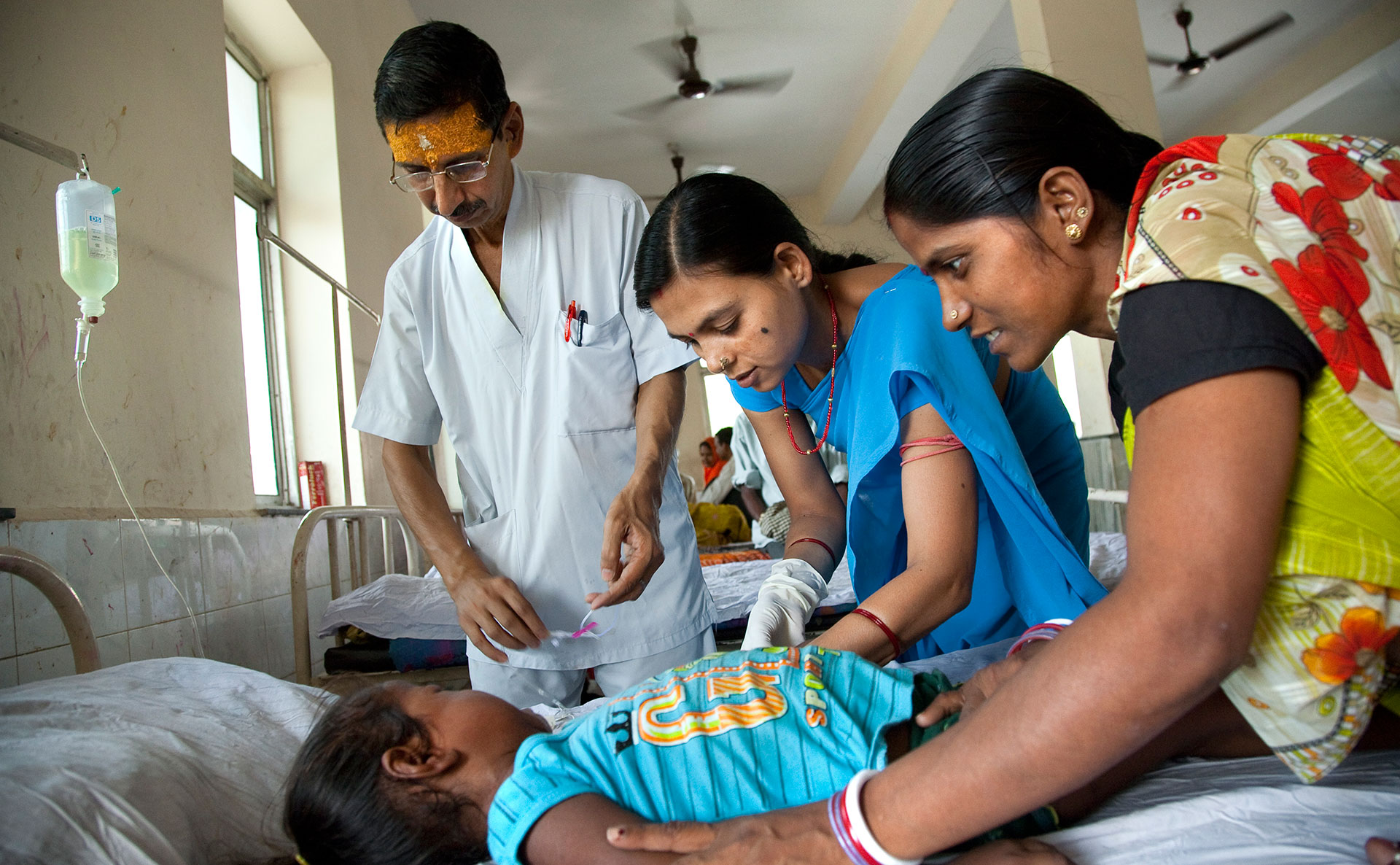 Photo Credit: DNDi
There are even fewer treatment options for Chagas disease. Nifurtimox and Benznidazole are the only
recognized treatments. Both drugs are effective when given soon after infection, but the efficacy of these
drugs decreases significantly as the disease progresses from the acute to the chronic phase5.
However, because the majority of infected individuals do not show symptoms in the early stages of the
disease, the effectiveness of these drugs has been limited. These drugs also cause side effects that lead to
discontinuation of treatment in more than 30% of patients12. Moreover, these treatments require
many doses over a prolonged duration, which results in poor patient adherence.
Photo Credit: DNDi
There are even fewer treatment options for Chagas disease. Nifurtimox and Benznidazole are the only
recognized treatments. Both drugs are effective when given soon after infection, but the efficacy of these
drugs decreases significantly as the disease progresses from the acute to the chronic phase5.
However, because the majority of infected individuals do not show symptoms in the early stages of the
disease, the effectiveness of these drugs has been limited. These drugs also cause side effects that lead to
discontinuation of treatment in more than 30% of patients12. Moreover, these treatments require
many doses over a prolonged duration, which results in poor patient adherence. Drug Discovery Partnership
Committed to finding effective treatments for Chagas disease and VL, the GHIT Fund supported a drug discovery partnership between Drugs for Neglected Diseases Initiative (DNDi) and pharmaceutical companies Eisai Co. Ltd, Shionogi & Co. Ltd., and Takeda Pharmaceutical Companay Limited. This unique partnership provides DNDi with access to the drug discovery portfolios and scientific expertise of the companies for the purpose of finding new treatments for both diseases.
GHIT’s “Hit-to-Lead Platform (HTLP)” is at the heart of the partnership and is a drug discovery approach that allows for rapid screening of compounds to find those most promising for treatment. Testing is conducted in a step-wise manner; initially, thousands of diverse compounds are screened to find a few promising drug candidates called “hits.” Hits are then optimized to create “leads” suitable for human testing, of which the most safe and effective are eligible to become drugs.
The partnership improves the probability of finding new treatments as compared to drug discovery efforts conducted individually at each of participating entities and is expected to identify at least 4 hits each for Chagas disease and VL within the next 2 years. Hopes are high that these “hits” will provide at least one lead drug candidate for each disease, which can then be advanced through more detailed safety and effectiveness studies during development.
Although the partnership is in its early stage, the GHIT Fund and its development partners are already considering how Chagas disease and VL drugs can be made affordable and accessible. Some of these considerations include:
- Testing – Extensive clinical testing must be performed to ensure that new Chagas disease and VL drugs are safer and more effective than currently available interventions. The development process itself must also be cost effective and efficient if these treatments are to become a reality. Since many of the compounds that will be evaluated by the HTLP are well characterized, the partnership has the potential to decrease the overall cost and time required for drug development.
- Cost – Affordable treatment options will be essential for reducing the health and economic impacts of Chagas disease and VL, as endemic areas are often the most impoverished.
- Stability – New treatment options must be stable enough to survive the temperature and humidity extremes of endemic areas. Otherwise, cost-effective shipping and storage requirements will need to be devised to ensure product integrity and patient access.
- Administration – To best ensure patient adherence, treatments would ideally be administered orally and require minimal doses to be effective.
- 1.McFalls Jr, Joseph A, and Marguerite Harvey McFalls. "Disease and fertility." (1983).
- 2."Chagas disease Symptoms - Diseases and Conditions ..." 2014. Accessed 15 Feb. 2015 <http://www.mayoclinic.org/diseases-conditions/chagas-disease/basics/symptoms/con-20030854>.
- 3.Bolivia NCAP project: Vallegrande findings | weADAPT 4.0." 2014. Accessed 15 Feb. 2015 <https://weadapt.org/knowledge-base/vulnerability/bolivia-ncap-project-vallegrande-findings>
- 4.Medrano-Mercado, Nora et al. "Urban transmission of Chagas disease in Cochabamba, Bolivia." Memórias do Instituto Oswaldo Cruz 103.5 (2008): 423-430.
- 5.WHO | Chagas disease (American trypanosomiasis)." Updated February 2015. Accessed 24 Feb. 2015 <http://www.who.int/mediacentre/factsheets/fs340/en/>
- 6.World Health Organization. "Research Priorities for Chagas Disease, HAT and Leishmaniasis"
2012. Accessed 24 Feb 2015
<http://www.who.int/iris/bitstream/10665/77472/1/WHO_TRS_975_eng.pdf> - 7."Chagas disease - PAHO/WHO." Accessed 15 Feb. 2015 <hhttp://www.paho.org/hq/index.php?option=com_topics&view=article&id=10&Itemid=40743>
- 8.WHO | Clinical forms of the leishmaniases." 2014. Accessed 19 Feb. 2015 <http://www.who.int/leishmaniasis/clinical_forms_leishmaniases/en/index2.html>
- 9.WHO | Leishmaniasis." Updated January 2004. Accessed 15 Feb. 2015 <http://www.who.int/leishmaniasis/en/>
- 10.Lee, Bruce Y et al. "Global economic burden of Chagas disease: a computational simulation model." The Lancet infectious diseases 13.4 (2013): 342-348.
- 11.Sarnoff, Rhonda et al. "The economic impact of visceral leishmaniasis on rural households in one endemic district of Bihar, India." Tropical Medicine & International Health 15.s2 (2010): 42-49.
- 12.da Silva, Gilberto Marcelo Sperandio et al. "A clinical adverse drug reaction prediction model for patients with Chagas disease treated with benznidazole." Antimicrobial agents and chemotherapy 58.11 (2014): 6371-6377.
